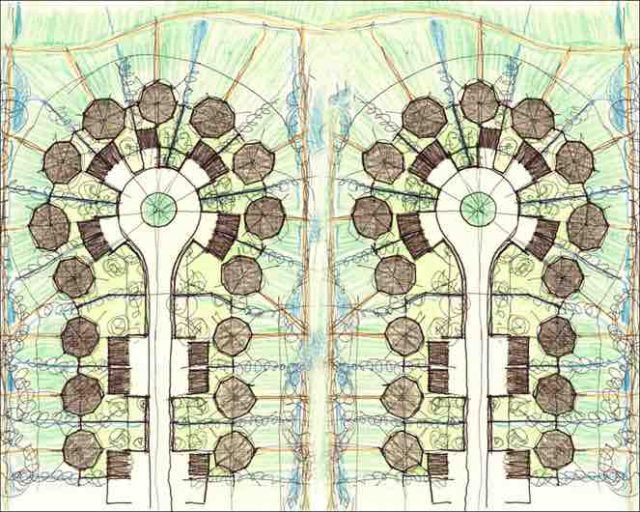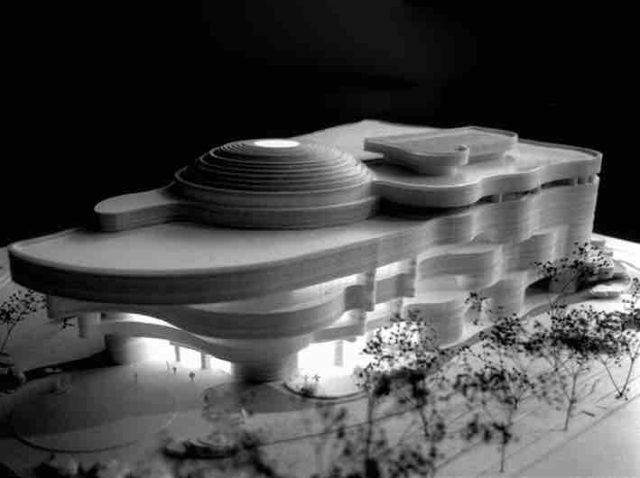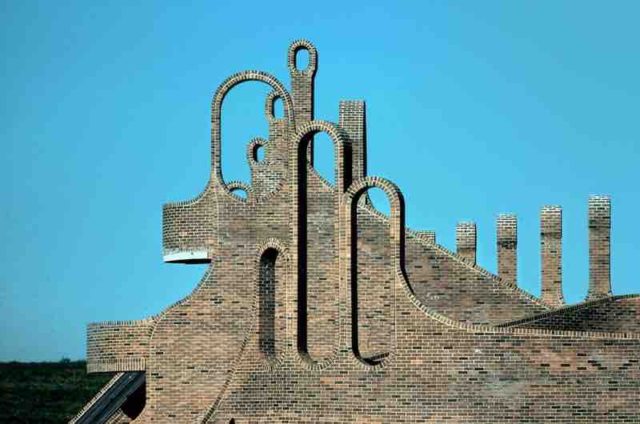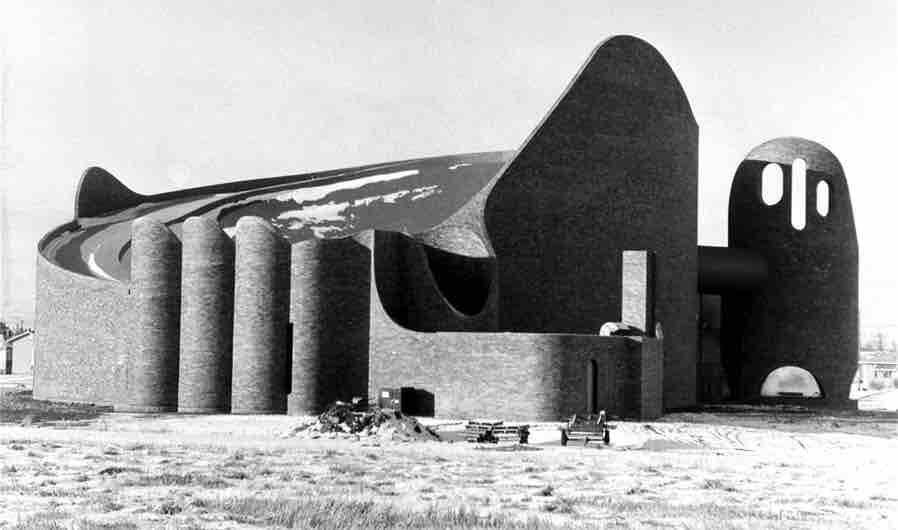About Douglas Cardinal
On the night of September 17, I entered a packed lecture hall in Macdonald Harrington, eager to see the architect whose work had initially drawn me towards architecture at a young age. As I entered the hall, the lights already dimmed and every seat filled, I joined those who were crouching on the steps of the aisles. That night, Douglas Cardinal challenged and upended the axioms and conventions on which I had built up my knowledge of architecture.
Renowned Blackfoot architect and activist Douglas Cardinal was born in Calgary in 1934 and studied architecture at the University of British Columbia and the University of Texas at Austin. Cardinal has been awarded over 20 honourary doctorates and the title of Officer of the Order of Canada. One of the most notable signatures of his work is organic, curvilinear forms and a resistance to conventional, rectilinear shapes commonly found in architecture. Cardinal approaches architecture through an Indigenous worldview which, he explains, is based on cooperation, responsibility to one’s community, respect of land and life, and respect towards one’s ancestors as well as future generations. Thus, Cardinal bases his work on the philosophy of organic architecture, which is centred on the relationships between human beings, architecture, and the environment, and approaches architecture as a greater living organism.
Cardinal began by picking up a black feather, explaining, “Elders told me to take it with me and remind me that I have to speak from my heart.” He began telling us about his childhood and family. His father, who was Anishinaabe, left his reserve and lived off the land. He was a hunter and trapper who sustained himself and his family off the land entirely, and raised Cardinal with the same skills and respect for the land and for life. “He realized that these animals gave up their lives so we could flourish, so we respected them.”
His mother was a nurse who worked at a mental hospital. Cardinal describes her with fondness, “she was a very strong woman and she was from German immigrants who settled in Alberta […] At that time women had no voice. They didn’t have the vote, and they were just property of men. But she would never stoop to that. She was very self-sufficient. She got an education, and she was her own person. The doctors wanted to marry her, but she would never be in a patriarchal system, like the healthcare system was at that time.
“When she met my father […] and of course he’s Anishinaabe, and the Anishinaabe people honoured women. And women were very important in Anishinaabe culture because they were primarily matrilineal and matriarchal. Women made all the decisions in the home, and made all the decisions for the community, and made all the decisions in the nation. And men […] honoured the decisions of the women and implemented them. That was very important for my mother, because she realized [that] if she stayed in the settler culture, she would be in a patriarchal system that […] she could not even think of tolerating. So she would rather live with my father. She quit her job, a very important job, and she moved to a little log cabin and raised eight children, and I’m the oldest.”
Cardinal then went on to talk about the impacts of settler colonialism and Catholic education on his childhood. “The problem came when I was around six or seven. My mother was Catholic. And the priest came in and said, ‘You can’t be married to this s*vage […] The only way you’ll have salvation is if you bring your children up Catholic.’ The priest convinced my mother to send me to a convent, and my two brothers, so we would be raised good Catholics. I spent half my time praying for my father, who was ‘such a s*vage,’ but to me, he was a very caring and loving human being. The people there at the convent […] were very abusive and talked about love but never followed through with it. […] I thought that truly my father was an amazing human being, and he taught me about loving and caring for all life. Because he lived it. He didn’t just talk about it. And I could understand why my mother loved him.
“So I wasn’t brought up on the reserve. But my mother wanted to make sure I was trained in the arts because she wanted me to be an architect. And I always listened to my mother.
“She trained me in the arts. That was the foundation for my background as an architect.
“But I could not remain a ‘good Catholic,’ or a good product of the colonies, because everything in my being rebelled against the programming I went through. The programming I went through was so challenging to me, mentally and physically, that I had tremendous anxiety attacks […] that would totally lay me flat. I could not tolerate that kind of thinking, that kind of mentality of the church and the state, because it was, for me… every cell in my body rebelled. So I had a very difficult time to survive.

“So at 15, I could not even take one more bit of society. I’d end up very sick with anxiety, and I’d run out to the trees and bush and totally get away from the settler society in order for me to even breathe. My whole nature, my whole way of being, rebelled against that society, and power, and control, and its [disrespect] for life […] and everything about it is disconnected from life and from nature, and our own nature.
“I found no value in the society that is based on a worldview that’s totally insane, as far as I can see, because our whole system rebelled against it. I dealt with it in a different way. I saw at that time that we come from two different worldviews.”
Two Different Worldviews
Cardinal distinguishes his worldview from that of settler-colonial society; the Indigenous worldview of his community, he explains, is based on individual responsibility, respect, and self-worth. In this worldview, power, as well as knowledge, resides within the individual. Indigenous society, according to Cardinal, is an extended family and is matriarchal. This society encourages cooperation as opposed to competition, and lives in harmony with nature and our own nature.
Settler-colonial society, on the other hand, is founded on power, hierarchy, and control, and enforces conformity to the dominant structures and institutions by fear and man-made laws. Within this settler-colonial structure, there is a constructed binary of good and evil, which allows individuals to deny responsibility for their actions due to an external, powerful evil. Knowledge is perceived as something one must attain in order to earn credibility, and contributions must be legitimized by those seen as more knowledgeable than you.
Cardinal rejects the settler-colonial worldview, its patriarchal structure, and its disregard for life. He emphasizes the importance of life, temporality, and responsibility to others, both past, present, and future: “In the hierarchical world view […] man is naturally territorial, develops weapons of mass destruction that continue to accelerate, and the spin-off of these technologies [are] primarily designed for warfare.”

Countering Settler Architecture
“So how would one plan if we have a different way of thinking?”
Cardinal draws from one of his projects, which was to create a land use plan for the Kamloops Indian Band, to demonstrate how he approached planning and design from an Indigenous perspective. “I was asked by the elders to plan some traditional territories, and they guided me through these principles. First of all, start with all the species at risk and lay out all of them, and their land, how its used… and cultural areas, traditional uses, and historical uses… that they used the land for, for millennia.
“Then we had to go out on the land and they pointed out all the species at risk, and to make sure we have proper habitats for their future. Because it’s a crime against a creator to kill species. And we kill species every day. We have no care for what we do. We’re so arrogant that we just destroy life around us, every day. They wanted to make sure that those species will be protected.”
He continues, pointing to a land use map delineated by various coloured and shaded zones, “The potential recreational areas [are for teaching] their children about how important it is to retain life on the land. And in doing so, showing the paths of different animals that had to be respected. So we respect the lives of all the animals around us. We had to even plan where they went for water. We had to make sure we respected their paths.
“And also to make sure the water source would be protected. And planning proper buffers around water so that the wetland plants that purify the water have an opportunity to be able to work with the way of nature, as the water flows to the wetlands before it flows into the creeks.
“We made certain that where we were developing, we weren’t going to destroy nature, because how can you have a future when you destroy all your life givers? Because the life givers, for us, are all the animals and birds, the fish, the plants…without them, how can we live? They gave up their lives so that we can live. So we have to respect them […] unless they thrive, we cannot thrive.
“You destroy your life givers, you destroy yourself. What are you gonna eat? A bunch of dollars?
“This is land use planning where you plan for land and nature, working together in harmony and balance, respect, and care. This is the way you plan.

“The way you learn how to plan, is absolutely insanity. You don’t even plan for the next generation. You destroy all life around you. You destroy forests, rivers. Look at our cities! Our cities are like grid-like cancerous growths that just expand like a virus on the planet, like a cancer. Polluting everything around them. It’s like a cancer that has no brain… it destroys its host and then at the end it gets destroyed too, because when the host dies it dies too. You can’t act like a virus and expect anything other than the result we’re getting on the planet right now. What kind of planning is that?”
“That’s planning for no future for our children.”
“[The elders] said, ‘don’t plan it like they planned Kamloops, because they planned it around their sewage systems […] instead of planning it around life and vitality. All the run-off from the roads and roofs of their houses, and all the pollution […] runs into the river and kills all the salmon. Don’t be like those settlers. They don’t respect the river, they don’t respect the salmon, they don’t respect life.’
Cardinal also planned the area, which was very dry, so that water could run on the land rather than in pipes. The plan was designed so that water would follow the drainage patterns of the land, and then collect in ponds with wetland plants that purify the water. Vehicular and pedestrian traffic was separated so that children and elders would not have to cross busy roads. Cardinal first designed the residential areas as cul-de-sacs, but the women in the community objected. “They said, ‘this is still too patriarchal… because you still have houses separated from each other in rows, and in doing so you separate the women from each other so you can control [them].’” The separation of houses inhibited the fostering of social networks between neighbouring women, children, and families. He then modified the design into circular clusters of five residential buildings, with a green recreational space for children in the center and roads on the outside of the clusters. Cardinal also designed Ouje’ Bougoumou Village for the Ouje’ Bougoumou Cree First Nation according to his circular cluster model.
“When women get together they will change things. Because they’re thinking of their children.”
Cardinal also stresses the importance of community consultation and designing in collaboration with communities, as opposed to making assumptions about the needs of these communities. Throughout his design process for the new Aanischaaukamikw Cree Cultural Institute in Ouje’ Bougoumou, he modified his design and presented it to the community at least eight times, until the community was satisfied with the proposed building. “Each person speaks from their heart. There’s no debate, it’s not about who’s right, or who wins, it’s about listening. Decisions are made by consensus. […] A lot of times people don’t know what they want, but they know what they don’t want, and that’s valuable information. So you have to listen to them.” As seen in the final design, the sloping roof of the building was intended to emulate the traditional shaptwam building form, and to reflect the desires of the local Cree community and house a cultural and artistic space.
For another ongoing project, Cardinal was tasked with designing residential buildings in Elsipogtog First Nations to address a housing crisis, in which existing homes were deteriorating from mould. He uses existing construction technology to design affordable, durable, and prefabricated homes, using solid wood as opposed to drywall, which has a tendency to collect moisture and thus form mould. He also aims to design these homes with net zero energy consumption, reducing utility costs for its inhabitants.
Fluid Forms
Many of Cardinal’s buildings are characterized by fluid, curvilinear forms. One of his most famous works, St. Mary’s Church in Red Deer, Alberta, is exemplary of his style; as he was designing the structure in the 1960s, he recalls, he relied on computers in order to solve thousands of mathematical equations simultaneously, and was told that his design was mathematically impossible. He headed to Chicago, where there was a computer that was capable of processing and proving these equations fast enough, and was able to formulate the fluid forms of the structure. St. Mary’s Church featured a swooping roof that was designed to create acoustics within the church that would carry sound without a microphone.
More of his famous works include the Canadian Museum of History, the National Museum of the American Indian, and the Adelante Healthcare Building. Commenting on his signature style, Cardinal explains, “All my buildings are curved because I respect the power of women and I want that expressed in the architecture and the forms of architecture. All my buildings are female. The greeks had Doric and Ionic forms, male and female forms, in their architecture. I chose my architecture to be Ionic, to be female-oriented, because I want my buildings to […] nurture people […] and provide them care, and love, and beauty.”
Architecture and Urban Planning as Colonial Practice
Cardinal rejects the colonial and capitalist structures that permeate architecture and urban design, recentering planning on the interests of communities, their continuity with the land, the environment, and life. Architectural practice and urban planning often reflect neoliberal, uncritical, and colonial tendencies. Concepts such as “sustainability” and “green roofs” are often used as nothing more than marketable buzzwords, attractive in concept but never upheld and implemented in practice. Urban planning has historically been and is still used as a settler-colonial tool of control, dominance, segregation, and the oppression of Indigenous peoples. Many post-colonial cities in the Global South, including those in Malaysia, India, Indonesia, and South Africa, were master-planned by European colonizers to segregate Indigenous and racialized people from white settlers, thus enforcing colonial rule and upholding white supremacy. This is also practiced in occupied Palestine by the Israeli government as a means of controlling Palestinian land and upholding an apartheid regime. Moreover, in North America, settlers on unceded land use urban planning and policy as a means of racial segregation. Land use policies such as racial zoning, for example, were first enacted in the US in the 20th century to push Black, Indigenous, immigrant, and racialized people out of desirable residential locations and distance them from white residents.
As Cardinal finished his lecture, he returned his gaze to the feather in his hand. “There’s always these ‘experts’ that know all about everything. They come in and they don’t speak from here at all,” he says, gesturing to his heart. “They speak from the head. To me, I think that when you’re designing a building you should speak from your heart. My culture tells me that the soft power of love is much greater than the hard power of force. That’s what my elders have always taught me.”
